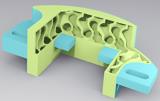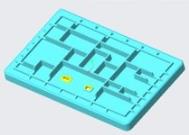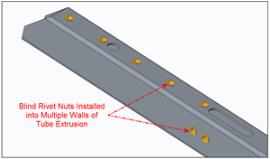Managing Model Items
A model item can either be a body, feature, product manufacturing information, or a drawing block information that is contained within a CAD file. When working with a model item, you can select a feature–such as an annotation element, or a piece of geometry– within a given Creo Parametric model and designate the feature. At the same time as designating the feature, you have the ability of specifying whether this designated feature should be considered a key characteristic.
Alternatively, you can specify whether the model item to be created in Windchill should be considered a BOM item, which will convey to Windchill that a corresponding part be created and represented in the product structure after a build.
Body
A body is a container object for solid geometry. It can contain parts of one or more geometric bodies that can be handled individually and can have different characteristics. For example, you can assign a different material to each body.
Bodies contain only solid geometry. Nonsolid entities, like datums, curves, and quilts, are not contained in any body. Each body has its own geometry. You can perform geometric operations such as splitting a body or merging with other bodies. Bodies contribute to the mass properties of the model. You can select bodies as references for features.
Here are some examples of body:
|
Additive manufacturing models
|
|
|
Overmolded models with silicon inserts
|
|
|
Sheetmetal parts that get fasteners to keep them bent
|
|
Annotation
Annotations are created within a
Creo Parametric model. When they are designated (see,
Designate Model Objects and Create Model Items), they typically represent product manufacturing information (PMI) to be verified as part of the manufacturing process. These are also called
Control Characteristics.
For example, GTOLs (geometric tolerances), Critical dimensions, etc.
For more information, see
Model Based DefinitionDesignate Model Objects
In Creo Parametric, you can use features or geometry to designate components in a BOM.
For example: Creo Parametric can designate a datum point to represent a standard fastener, rivet. On a large model, like an aircraft wing, you do not want the small edges of a rivet to slow down a model regeneration; however the quantity of rivets is based on the size of the wing.
You can pattern a set of datum points, and then designate these points so they capture the parametric quantity of rivets required for the wing.
You can designate Creo features, annotation elements, geometry, and other model objects. Additionally, you can designate annotation elements as controlled characteristics. The designation of model objects generates neutral data in the Creo applications. This neutral data creates object types called model items for the designated model objects when you check in the models to Windchill.





